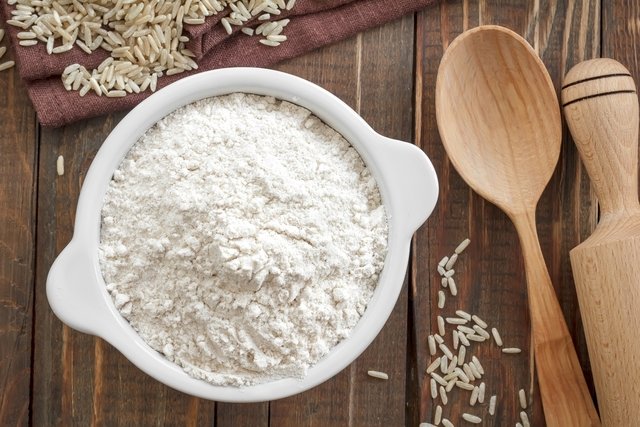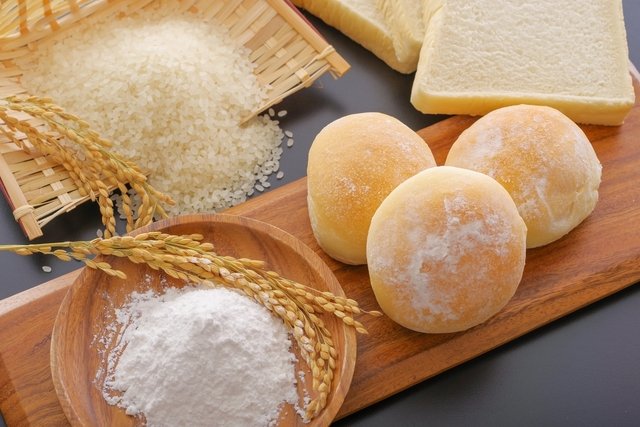Rice flour is a product that is made by crushing white or brown rice grains. It is a great option for those with celiac disease and gluten intolerance.
Rice flour is also great for treating constipation, promoting weight loss and for gaining muscle mass. It is rich in fiber and carbohydrates that can help to manage hunger and increase physical stamina during training.
Rice flour can be found in white or whole grain form, and purchased at grocery stores and health food stores. It can be used to prepare pies, breads, pancakes and cakes.

Health benefits
The main health benefits of rice flour are:
1. Treating constipation
Rice flour is high in fiber, especially its whole grain form, and is therefore effective for treating constipation. It stimulates natural contractions in the intestine, which can facilitate bowel movements.
Check-out other laxative foods that you can consume to treat or prevent constipation.
2. Promoting muscle mass gain
Rice flour promotes muscle mass gain, as it is rich in carbohydrates, a nutrient that is essential for boosting energy and stamina during exercise. It can also improve muscle recovery after exercise.
Rice flour also contains excellent amounts of zinc and magnesium. These are minerals that are important for muscle contraction and relaxation, and can help with increased muscle strength and endurance. These minerals are also needed for the production of testosterone.
Also recommended: 16 Muscle-Building Foods to Eat to Gain Muscle (w/ Meal Plan) tuasaude.com/en/muscle-building-foods3. Preventing cardiovascular diseases
Because it is rich in selenium and magnesium, rice flour has a natural antioxidant action that prevents the oxidation of fat cells. It can play a role in managing LDL cholesterol levels, and can therefore help to prevent cardiovascular diseases, such as atherosclerosis, heart attack and stroke.
Furthermore, rice flour is a high-fiber food, which reduces the absorption of fats in the intestine. This can, in turn, reduce cholesterol and triglyceride levels in the blood.
4. Maintaining bone health
Rice flour helps maintain bone health as it contains phosphorus and magnesium. These are minerals that promote optimal vitamin D levels. They are also essential for the production of the cells that are responsible for the formation and maintenance of bones.
5. Strengthening hair
Rice flour is high in zinc, which is important for the development, growth and repair of hair strands. This mineral helps to strengthen the hair and prevent hair loss.
6. Promoting weight loss
Rice flour facilitates weight loss because it is rich in fiber, a nutrient that forms a type of gel in the stomach. This increases the time it takes to digest food, which can reduce hunger throughout the day.
However, to help with weight loss, rice flour should be included in a low-calorie diet and a part of an active lifestyle.
Also recommended: Weight Loss Diet: Best Foods to Eat, Avoid & Meal Plan tuasaude.com/en/weight-loss-diet7. Preventing diabetes
Rice flour has excellent amounts of fiber, a nutrient that slows down carbohydrate absorption. It helps to control blood sugar levels, and prevent insulin resistance and diabetes.
8. Strengthening the immune system
Rice flour strengthens the immune system as it has excellent amounts of iron, selenium and niacin. These are nutrients that promote immune cell development functioning, protecting the body against viruses, bacteria and fungi.
Also recommended: Immune System Boosters: Foods, Natural Remedies & Recipes tuasaude.com/en/immune-system-boostersDoes rice flour lead to weight gain?
Because rice flour is high in carbohydrates, it can lead to weight gain when consumed in large quantities.
When used in high-calorie preparations, such as pies, fried foods and sweets, for example, rice flour can lead to weight gain.
However, rice flour is rich in fiber that helps prolong satiety, controlling hunger throughout the day. Therefore, when consumed in moderation and in healthy recipes, rice flour can help with weight loss.
Nutritional information
The following table outlines the nutritional information for 100 g of white and brown rice flour:
To obtain all the benefits that rice flour has to offer, it is also important to maintain a healthy, balanced diet and to exercise regularly.
How to make rice flour
To make rice flour, you only need 1 kg of raw white or brown rice. The step-by-step guide to make this flour at home is as follows:
- Inspect the rice grains and remove any impurities.
- Place 1/2 cup of rice grains in a blender or processor, and blend until the grains are well-crushed.
- Sift the crushed grains through a sieve.
- Return the grains that remained in the sieve to the blender, adding another ½ cup of whole rice grains.
- Repeat the process, with the rest of the rice, until you have the necessary amount of flour.
This flour can be used in preparations such as bread, pasta, pizza, cake, pancakes, pies, cookies and crepes.
Rice flour can replace any gluten flour with gluten, and is a great alternative for those with gluten intolerance or celiac disease. Celiac disease is an autoimmune disease characterized by a permanent intolerance to gluten, causing inflammation and damage to the intestine.
Healthy rice flour recipes

Some healthy and tasty recipes with rice flour are:
1. Brown rice flour and tapioca flour bread
Ingredients:
- 1 cup (tea) of brown rice flour;
- ½ cup of sweet cassava starch;
- 1 tablespoon of baking powder;
- 1 teaspoon of salt;
- 2 tablespoons of flaxseeds;
- 2 tablespoons of sunflower seeds;
- 1 cup (tea) of water;
- 3 eggs;
- 1 drizzle of olive oil.
Directions:
Preheat the oven to 180 ºC (or 350 ºF). Place the water and eggs in the blender and blend for 1 minute. Gradually add the other ingredients, except the seeds, and beat for a few more minutes or until the mixture is well-combined.
Then the seeds to the batter, mixing with a spoon. Pour the dough into a pan greased with olive oil. Place the dough in the oven to bake for 30 minutes. Wait for it to cool and serve.
2. Rice flour cake
Ingredients:
- 4 cups of rice flour;
- 2 cups of milk or plant-based milk;
- 3 eggs;
- 1 cup of brown sugar;
- 1 cup of olive oil or other vegetable oil;
- 1 pinch of salt;
- 1 tablespoon of baking powder.
Directions:
Preheat the oven to 180 ºC (or 350 ºF). Place all the ingredients in a blender and blend for 5 minutes or until the mixture is well-combined. Transfer the dough to a greased pan or tray and place in the oven to bake for 35 to 40 minutes, or until golden. Leave to cool and then serve.
3. Rice flour pancake
Ingredients:
- 1 cup of milk or plant-based milk;
- 1 cup (tea) rice flour;
- 1 tablespoon of melted butter;
- 1 tablespoon of baking powder;
- 1 egg;
- 1 tablespoon of brown sugar or culinary sweetener.
Directions:
Using a spoon, mix the flour, yeast, sugar and salt in a container. In another bowl, mix the milk, butter and egg well, using a whisk. Add this mixture to the dry ingredients and mix well.
Place a non-stick frying pan over medium heat, pour a ladle of dough into the pan and let it brown on both sides. You can serve this pancake with your preferred toppings, such as fruit, peanut butter or fruit jelly.
